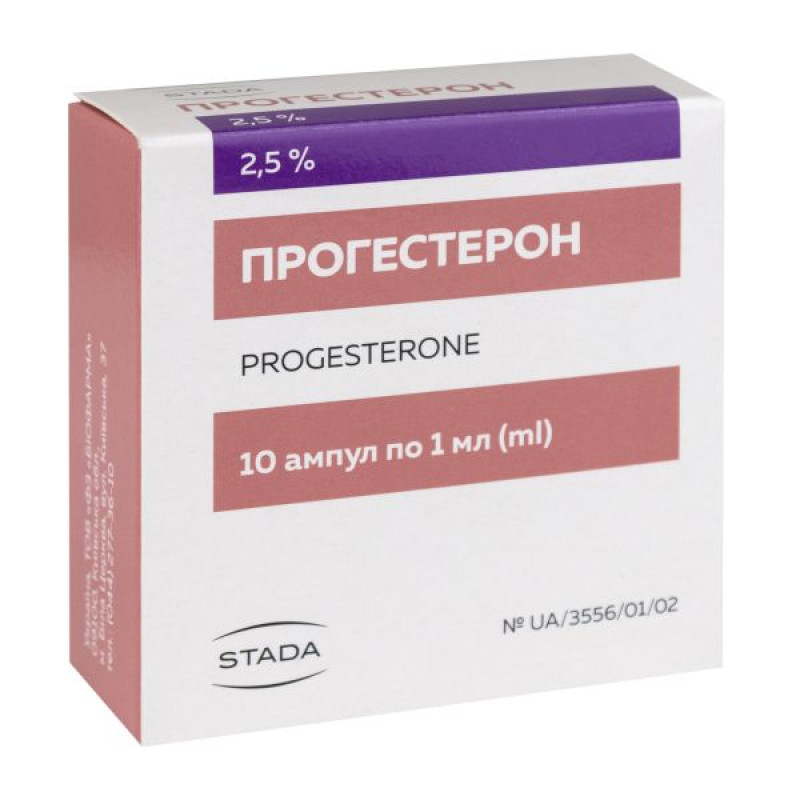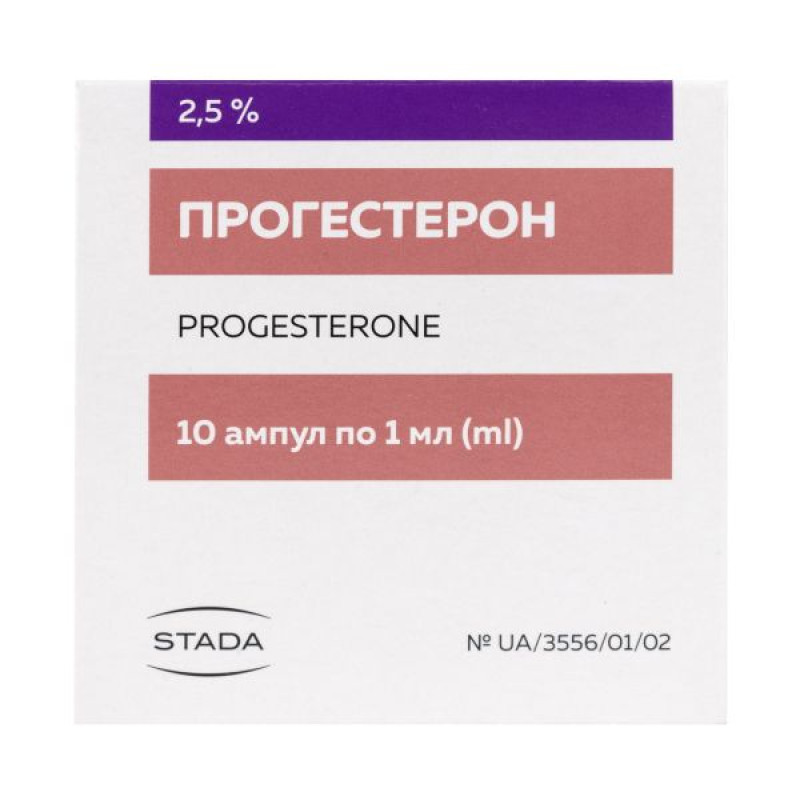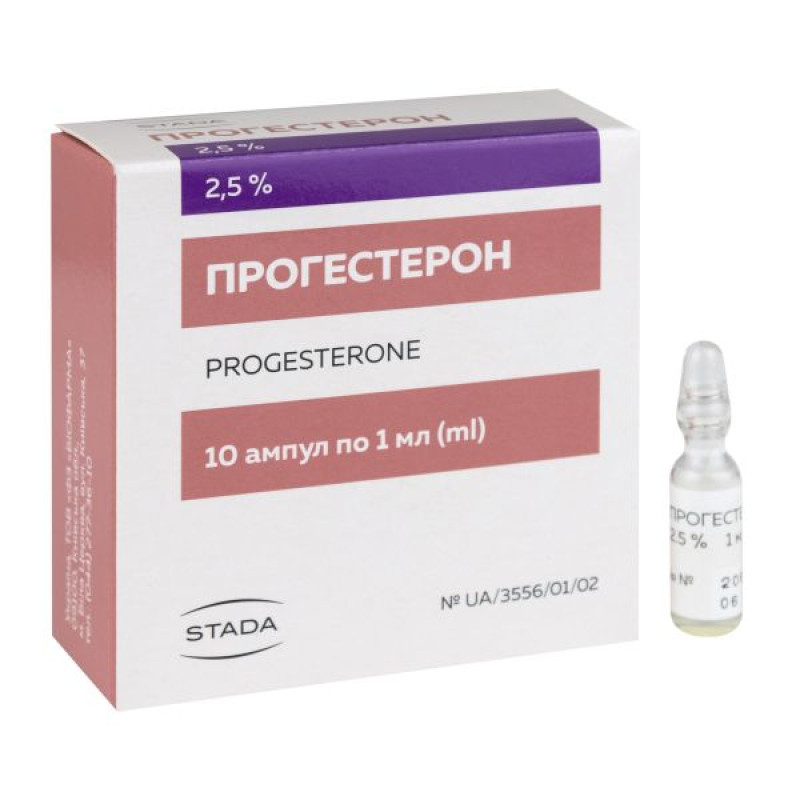Progesterone oil solution for injection 2.5% ampoule 1 ml No. 10

Translation of the instructions can be
PROGESTERONE oily solution for injection 1%, oily solution for injection 2.5%I n s t r u c t i o n
For medical use of the medicinal product
Progesterone
(Progesterone)
Composition:
Active ingredient: 1 ml of the drug contains 10 mg or 25 mg of progesterone;
excipients: benzyl benzoate, refined olive oil.
Dosage form.
Oily solution for injection.
Main physicochemical properties: transparent oily liquid from light yellow to greenish yellow in color.
Pharmacotherapeutic group.
Hormones of the sex glands and drugs used in pathologies of the genital area. gestagens.
PBX code G03D A04.
Pharmacological properties.
Pharmacodynamics.
Progesterone is a hormone of the corpus luteum; it causes the transition of the uterine mucosa from the proliferation phase caused by follicular hormone to the secretory phase, and after fertilization promotes its transition to the state necessary for the development of a fertilized egg. It also reduces the excitability and contractility of the muscles of the uterus and fallopian tubes, stimulates the development of the terminal elements of the mammary gland. In small doses, it stimulates, and in large doses, it inhibits the secretion of gonadotropic hormones. It inhibits the action of aldosterone, which leads to increased secretion of sodium and chlorine with urine. It has a catabolic and immunosuppressive effect.
Pharmacokinetics.
After intramuscular and subcutaneous administration, it is rapidly and almost completely absorbed. It is metabolized in the liver, forming conjugates with glucuronic and sulfuric acids. The main product of progesterone conversion is biologically active pregnanediol. Pregnanediol, after conjugation with glucuronic acid, enters the blood from the liver and then into the urine. A smaller part of progesterone is converted into pregnenolol and pregnanedione. All progesterone metabolites excreted in the urine are inactive.
The half-life is several minutes.
50-60% is excreted in the urine, more than 10% in the bile.
The amount of metabolites excreted in the urine varies depending on the phase of the corpus luteum.
Clinical characteristics.
Indication.
Amenorrhea, anovulatory uterine bleeding, endocrine infertility, including those caused by corpus luteum insufficiency, miscarriage, oligomenorrhea, algodysmenorrhea (due to hypogonadism).
Contraindication.
Liver disease, liver dysfunction, hepatitis, hepatic and renal failure; cholestatic jaundice during pregnancy (in history), benign hyperbilirubinemia; neoplasms of the breast and genitals; tachycardia, tendency to thrombosis, active venous or arterial thromboembolism, severe thrombophlebitis or these conditions in history; nervous disorders with depression; porphyria; pregnancy after the 36th week, ectopic pregnancy or pregnancy that has frozen in history; vaginal bleeding of unknown genesis, condition after abortion; hypersensitivity to the components of the drug.
Interaction with other drugs and other types of interactions.
Progesterone weakens the effect of drugs that stimulate myometrial contractions (oxytocin, pituitrin), anabolic steroids (retabolil, nerobol), pituitary gonadotropic hormones. When interacting with oxytocin, the lactogenic effect decreases. It enhances the effect of diuretics, antihypertensive drugs, immunosuppressants, bromocriptine and systemic coagulants. It reduces the effectiveness of anticoagulants. The effect of progesterone decreases with the simultaneous use of barbiturates. It changes the effects of hypoglycemic agents. When used simultaneously with inducers of liver enzymes, an increase or decrease in the concentration of progesterone in the blood plasma is possible.
Application features.
It should be used with caution in diseases of the cardiovascular system, arterial hypertension, chronic renal failure, diabetes mellitus, bronchial asthma, epilepsy, migraine, depression, hyperlipoproteinemia.
Progesterone should also be used with caution in patients with a history of mental disorders, and the drug should be discontinued at the first signs of depression.
Patients with diabetes need to carefully monitor blood glucose levels.
When using Progesterone, it is necessary to be attentive to early signs and symptoms of thromboembolism, and if they occur, therapy with the drug should be discontinued.
Since the metabolism of steroid hormones occurs in the liver, Progesterone should not be used in patients with impaired liver function.
With prolonged use of large doses of Progesterone, menstruation may stop.
The drug should not be used in cases of bleeding from the genital tract, the cause of which is not established, and in patients with a history of peripheral arterial disease. During treatment, regular examinations are recommended, the frequency and volume of which are determined individually.
If there is any progesterone-dependent tumor, for example, meningioma in the past and/or its progression during pregnancy or previous hormonal therapy, patients should be under close medical supervision.
During pregnancy, the drug should only be used for the prevention and treatment of threatened miscarriage. After the 36th week of pregnancy, the drug is contraindicated. Do not use the drug for women planning a pregnancy in the near future. The risk of congenital anomalies, including sexual anomalies in children of both sexes, associated with the action of exogenous progesterone during pregnancy has not been fully established. Progesterone passes into breast milk, so the drug should not be used during breastfeeding.
The ability to influence the reaction speed when driving vehicles or other mechanisms.
The drug may cause dizziness and drowsiness. During treatment, it is necessary to refrain from driving vehicles and engaging in potentially hazardous activities that require increased attention and speed of psychomotor reactions.
Method of administration and doses.
Before use, the ampoule with the drug should be slightly warmed up in a water bath (up to 30-40 ºС). In case of crystals, the ampoule should be heated in a boiling water bath until they are completely dissolved. The drug should be administered intramuscularly or subcutaneously.
In case of anovulatory uterine bleeding, the drug is prescribed at 5-15 mg daily for 6-8 days. If curettage of the uterine cavity mucosa has been performed beforehand, then injections should be started after 18-20 days. If curettage is not possible, the drug should be administered during bleeding. In this case, bleeding may temporarily (for 3-5 days) increase; patients with moderate and severe anemia are recommended to undergo a blood transfusion (200-250 ml) beforehand. If bleeding has not stopped after 6-8 days of treatment, further administration of progesterone is inappropriate. If bleeding has stopped, treatment should not be interrupted earlier than 6 days.
For hypogonadism and amenorrhea, administer (immediately after the use of estrogenic drugs) 5 mg daily or 10 mg every other day for 6-8 days.
For the prevention and treatment of threatened miscarriage caused by insufficiency of the corpus luteum - 10-25 mg daily or every other day until the risk of miscarriage is completely eliminated. In case of habitual miscarriage, the drug can be administered up to the 4th month of pregnancy.
In case of algodysmenorrhea, to reduce or eliminate pain, the drug should be administered 6-8 days before menstruation at 5-10 mg daily for 6-8 days. The course of treatment can be repeated several times. The highest single and daily dose intramuscularly is 25 mg (2.5 ml of 1% solution or 1 ml of 2.5% solution). Progesterone treatment of algodysmenorrhea associated with uterine hypoplasia can be combined with prior administration of estrogen drugs.
Children.
The drug should not be used in pediatric practice.
Overdose.
When using increased doses of the drug, side effects described in the relevant section occur more often. If side effects appear, treatment with the drug should be discontinued, and after they disappear, continue in lower doses. If necessary, carry out symptomatic treatment.
Adverse reactions.
Progesterone is usually well tolerated, but in some cases the following side effects may occur:
from the cardiovascular system: tachycardia, circulatory disorders, increased blood pressure, venous thromboembolism;
from the nervous system: headache, dizziness, drowsiness, insomnia, depression;
from the reproductive system and mammary glands: swelling, increased sensitivity and pain of the mammary glands, disorders of the external genital organs, such as burning, dryness, genital itching, change in vaginal discharge, bleeding, vaginal mycosis, premenstrual syndrome, menstrual cycle disorders, acyclic spotting, amenorrhea, oligomenorrhea, hirsutism, decreased libido, uterine spasms;
from the digestive tract: bloating, abdominal pain, nausea, vomiting, constipation, diarrhea, flatulence;
endocrine disorders: poor glucose tolerance;
Respiratory system: shortness of breath;
Liver: liver dysfunction and changes in liver function tests; cholestatic jaundice;
metabolic and nutritional disorders: change in appetite, increase or decrease in body weight, edema, albuminuria;
Skin and soft tissue disorders: allergic skin reactions, erythema multiforme, itching, urticaria, skin rash, acne, chloasma, alopecia, hirsutism;
General disorders and administration site conditions: fatigue, weakness, fever, hypersensitivity reactions including anaphylactic reactions; fluid retention, paresthesia; injection site conditions including pain and swelling;
laboratory indicators: change in plasma lipid profile;
effect on the fetus: excessive amounts of progesterone can lead to virilization of the female fetus (up to uncertainty of gender).
Expiration date.
5 years.
Storage conditions.
Store in the original packaging to protect from light at a temperature not exceeding 25 ° C. Keep out of the reach of children.
Incompatibility.
The drug should not be mixed with other medications.
Packaging.
1 ml of the drug in an ampoule. 10 ampoules in a cardboard pack. 5 ampoules in a blister, 2 blisters in a cardboard pack.
Vacation category.
According to the recipe.
Producer.
LLC "FZ" Biofarma ", Ukraine.
Location of production and its address of place of business.
Ukraine, 09100, Kyiv region, M. Bila Tserkva, Kyivska st., 37.
There are no reviews for this product.
There are no reviews for this product, be the first to leave your review.
No questions about this product, be the first and ask your question.










